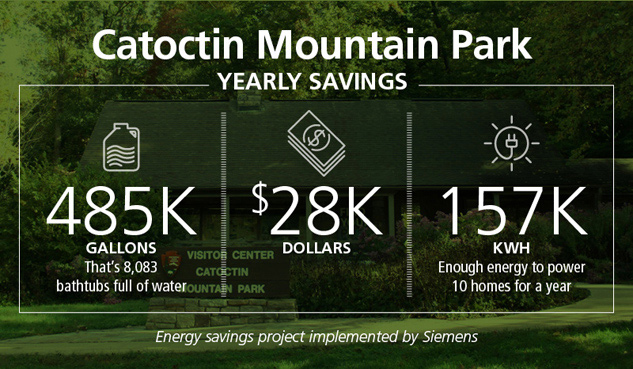The National Park Service is investing $29 million in 81 individual energy efficiency and water conservation projects at national parks throughout the greater Washington region.

NPS / Siemens
Reducing Energy Consumption
Energy Savings Performance Contract
As part of the larger National Capital Region (NCR) Energy Savings Performance Contract (ESPC) project, Catoctin Mountain Park:
-
Replaced interior and exterior lighting with LED bulbs.
-
Retrofitted old light fixtures and installed occupancy sensors and programmable thermostats, and trained park staff how to use them.
-
Replaced the HVAC systems at the Visitor Center and resource management building with high efficiency units.
-
The installation of energy efficient water equipment will reduce water consumption and hot water energy usage, and lower the operating costs of the facility through utility savings.
These measures will reduce water consumption and energy use, lowering the overall operating costs of the facility. Catoctin Mountain Park expects to reduce their GHG emissions by 15 percent through the ESPC.
Reducing Water Consumption
In an effort to reduce water consumption, Catoctin Mountain Park:
-
Installed low-flow faucets and shower heads, and low-flow plumbing equipment including waterless urinals.
-
Installed rain barrels at Round Meadow to demonstrate wastewater saving opportunities.
- Reduced overall water use by fixing leaks and replacing inefficient fixtures.
Reducing Emissions from Transportation
Clean Cities Program Grant
The U.S. Department of Energy's (DOE’s) Clean Cities Program, in partnership with the NPS’s Clean Cities National Parks Initiative, supports local actions to cut petroleum use in transportation. In May 2014, Catoctin Mountain Park was awarded a Clean Cities Program Grant, and with the grant money:
-
Installed five electric vehicle charging stations (EVSE) in three locations – the Visitor Center, Camp Round Meadow, and Park Headquarters.
-
Replaced two older gasoline vehicles with plug-in hybrid electric Ford C-Max vehicles.
-
Replaced three diesel lawnmowers with propane mowers.
Reducing Solid Waste
To help reduce solid waste, Catoctin Mountain Park:
-
Expanded the recycling program within the park, by increasing the types of materials that can be recycled at the park, including batteries, metal, and construction materials.
-
Installed composting units at Camp Greentop and Round Meadow.
-
Reduce paper waste through duplex printing and use of electronic alternatives.
Reducing Light Pollution
Night Sky Program
The NPS uses the term natural lightscape to describe resources and values that exist in the absence of human-caused light at night. Natural lightscapes are critical for nighttime scenery and many wildlife species rely on natural patterns of light and dark for navigation, to cue behaviors, or hide from predators.
To enhance their natural lightscape, Catoctin Mountain Park:
-
Installed outdoor light poles with down lighting and motion sensors in the cabin camps.
-
Reduced the overall number of lights in the park.
- Relocated the new light poles for maximum efficiency.
Increasing Climate Change Education Efforts
Education and Outreach
Catoctin Mountain Park’s education and outreach efforts are ongoing and extend beyond park staff to include visitors and the local community. These efforts include:
-
Educating visitors about climate change risks and impacts, and the actions they can personally take to help reduce GHG emissions at Catoctin Mountain Park.
-
Educating park staff on actions that will reduce GHG emissions and decrease overall costs.
-
Working with the League for People with Disabilities to promote composting and recycling.
-
Encouraging park staff to participate in the Climate Friendly Park Workshop, where several presenters discussed ways they can save energy.
-
Creating signage to encourage energy-saving behavior, for example, signs to remind visitors to turn off the lights throughout the park.
-
Discussing energy use and reduction goals with groups that lease the cabin camps and dorms.
-
Developing educational materials for visitors and park staff.
-
Using Facebook, Twitter, YouTube, Flickr and press releases to share environmental messages.
Last updated: September 13, 2016
